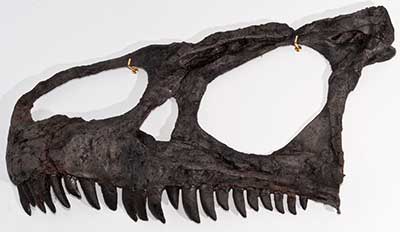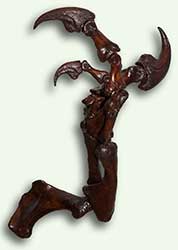Allosaurus
(AL-oh-SAW-rus)
| Quick Facts | |
|---|---|
| Name Meaning: | Different Lizard |
| Distribution: | Utah, Colorado, Montana, New Mexico, Montana, USA |
| Time Period: | Late Jurassic, 156-130 Ma |
| Length: | 36 ft (11m) |
| Weight: | 2 tons |
| Diet: | Carnivore |
| Linnaean Classification | |
| Kingdom: | Animalia |
| Phylum: | Chordata |
| Class: | Reptilia |
| Superorder: | Dinosauria |
| Order: | Saurischia |
| Suborder: | Theropoda |
| Infraorder: | Carnosauria |
| Family: | Allosauridae |
| Genus: | Allosaurus |
| Cladistic Classification | |
| |

History
 |
| Allosaurus talons. |
Description
The Allosaurus was one of the greatest carnivores of the Jurassic period, the Tyrannosaurus of its time. It had a larg e heavy body with a long tail to balance its body. The arms had three clawed fingers, and each foot also had three clawed toes. The neck was S-shaped to support its head. The head was the most distinguishing feature of the Allosaurus. It was actually a lot lighter than it appears. The jaws had the ability of opening wide and then expanding in order to bite a huge chunk of meat.Lifestyle
The Allosaurus probably spent time lurking in the undergrowth waiting for an unsuspecting herbivore to pass by. They may have also hunt in packs, preying on the stragglers in a large herd of herbivores, like the young, old, and wounded. They may have also been hostile towards each other. Bone marrow was discovered in an Allosaurus that died at about the age of 10. This particular bone marrow is known to exist in modern female birds to produce calcium to lay eggs. This implies that the Allosaurus were sexually developed long before complete growth. The younger Allosaurus also have been known to have longer legs making them perhaps faster while running.
ScienceViews Writer: Jason Hamilton.
Copyright © 2005-2010 Calvin & Rosanna Hamilton. All rights reserved.